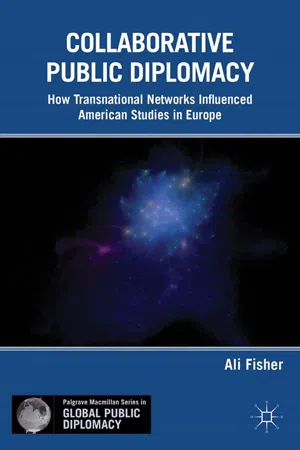
eBook - ePub
Collaborative Public Diplomacy
How Transnational Networks Influenced American Studies in Europe
This is a test
- English
- ePUB (mobile friendly)
- Available on iOS & Android
eBook - ePub
Collaborative Public Diplomacy
How Transnational Networks Influenced American Studies in Europe
Book details
Book preview
Table of contents
Citations
About This Book
Using archival research and recorded interviews, this book charts the development of American Studies in Europe during the early Cold War. It demonstrates how negotiations took place through a network of relationships and draws lessons for public diplomacy in an age when communities are connected through multi-hub, multi-directional networks.
Frequently asked questions
At the moment all of our mobile-responsive ePub books are available to download via the app. Most of our PDFs are also available to download and we're working on making the final remaining ones downloadable now. Learn more here.
Both plans give you full access to the library and all of Perlego’s features. The only differences are the price and subscription period: With the annual plan you’ll save around 30% compared to 12 months on the monthly plan.
We are an online textbook subscription service, where you can get access to an entire online library for less than the price of a single book per month. With over 1 million books across 1000+ topics, we’ve got you covered! Learn more here.
Look out for the read-aloud symbol on your next book to see if you can listen to it. The read-aloud tool reads text aloud for you, highlighting the text as it is being read. You can pause it, speed it up and slow it down. Learn more here.
Yes, you can access Collaborative Public Diplomacy by A. Fisher in PDF and/or ePUB format, as well as other popular books in Politics & International Relations & International Relations. We have over one million books available in our catalogue for you to explore.
Information
N O T E S
Preface
1.Manuel Castells, The Rise of the Network Society, (Oxford: Blackwell Publishers, 1996).
2.M. Lewis, Moneyball: The Art of Winning an Unfair Game, (New York: W. W. Norton, 2004).
3.Lewis, Moneyball, 147.
4.Lewis, Moneyball, 147.
5.See Pierre Pahlavi, “Evaluating Public Diplomacy Programmes,” The Hague Journal of Diplomacy 2, no. 3 (October 2007): 255–81; Louise Vinter and David Knox, “Measuring the Impact of Public Diplomacy: Can It Be Done?” Engagement: Public Diplomacy in a Globalised World (London: Foreign and Commonwealth Office, 2008), 166.
Introduction The Role of Networks in Public Diplomacy
1.G. Cowan and A. Arsenault, “Moving from Monologue to Dialogue to Collaboration: The Three Layers of Public Diplomacy,” The ANNALS of the American Academy of Political and Social Science 616, no. 1 (March 1, 2008): 10–30.
2.For a history of network analysis, see John P. Scott, Social Network Analysis: A Handbook, 2nd ed. (London: Sage Publications Ltd, 2000).
3.Valdis Krebs, “Mapping Networks of Terrorist Cells,” Connections 24, no. 3 (2002): 43–52; Thomas W. Valente, Social Networks and Health: Models, Methods, and Applications, 1st ed. (New York: Oxford University Press, 2010); Everett M. Rogers, Diffusion of Innovations (New York: Simon and Schuster, 1995).
4.Thomas W. Valente, “The Diffusion Network Game,” Connections 19, no. 2 (1996): 30–37. Also see Franco Malerba and Nicholas S. Vonortas, Innovation Networks in Industries (Cheltenham, UK: Edward Elgar Publishing, 2009).
5.Mark Granovetter, “The Strength of Weak Ties,” American Journal of Sociology 78, no. 6 (1973): 1360–1380.
6.Joel Levine, “The Sphere of Influence,” American Sociological Review 37, no. 1 (1972): 14–27.
7.Mark Gerzon, Global Citizens (London: Rider, 2010).
8.Ali Fisher, “Bullets with Butterfly Wings,” in Yahya R. Kamalipour (Ed.), Media, Power, and Politics in the Digital Age: The 2009 Presidential Election Uprising in Iran (Lanham, MD: Rowman & Littlefield Publishers, 2010).
9.R. Hill and R. Dunbar, “Social Network Size in Humans,” Human Nature 14, no. 1 (March 1, 2003): 53–72; W. X. Zhou, D. Sornette, R. A. Hill, and R. I. M. Dunbar, “Discrete Hierarchical Organization of Social Group Sizes,” Procee dings of the Royal Society B: Biological Sciences 272, no. 1561 (February 22, 2005): 439–44.
10.John F. Nash, “Two-Person Cooperative Games,” Econometrica 21, no. 1 (January 1, 1953): 128–40.
11.John F. Nash, “The Bargaining Problem,” Econometrica 18, no. 2 (1950): 155–62; John F. Nash, “Equilibrium Points in N-Person Games,” Proceedings of the National Academy of Sciences 36, no. 1 (January 1, 1950): 48–49.
12.R. B. Myerson, “Refinements of the Nash Equilibrium Concept,” International Journal of Game Theory 7 (June 1978): 73–80.
13.John F. Nash, “Non-Cooperative Games,” The Annals of Mathematics 54, no. 2, Second Series (1951): 286–95.
14.Thomas Schelling, “Arms and Influence,” in Thomas Mahnken and Joseph A. Maiolo (Eds.), Strategic Studies: A Reader, 1st ed. (London: Routledge, 2008).
15.Kathy Fitzpatrick, “U.S. Public Diplomacy in a Post-9/11 World: From Messaging to Mutuality,” CPD Perspectives on Public Diplomacy, Paper 6, October 2011.
16.Bureau of Public Affairs Department Of State, The Office of Electronic Infor mation, “21st Century Statecraft,” March 16, 2011, http://www.state.gov/statecraft/overview/index.htm; “Public Diplomacy in the Twenty-First Century [Rush Transcript; Federal News Service],” Council on Foreign Relations, n.d., http://www.cfr.org/diplomacy/public-diplomacy-twenty-first-century-rush-transcript -federal-news-service/p16698.
17.Luc Van den Brande, “Sub-Sta...
Table of contents
- Cover
- Title page
- Copyright
- Dedication
- Contents
- Preface
- Introduction The Role of Networks in Public Diplomacy
- One Navigating from the Salzburg Seminar to EAAS
- Two Making an Exhibition of Yourself
- Three Amerika Institut—Munich
- Four The Founding of GAAS
- Five The Founding of BAAS
- Conclusion Building Blocks for a Collaborative Approach to Public Diplomacy
- Notes
- Index